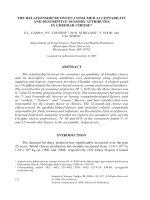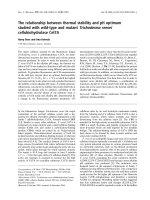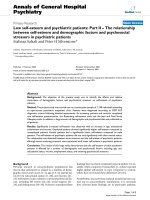the relationship between cnsumer acceptability and descriptive sensory attributes in cheddar cheese
Bạn đang xem bản rút gọn của tài liệu. Xem và tải ngay bản đầy đủ của tài liệu tại đây (146.5 KB, 16 trang )
THE RELATIONSHIP BETWEEN CONSUMER ACCEPTABILITY
AND DESCRIPTIVE SENSORY ATTRIBUTES
IN CHEDDAR CHEESE*
E.L. CASPIA
1
, P.C. COGGINS
1,2
, M.W. SCHILLING
1
, Y. YOON
1
and
C.H. WHITE
1
1
Department of Food Science, Nutrition and Health Promotion
Mississippi State University
Mississippi State, MS 39762
Accepted for publication November 8, 2005
ABSTRACT
The relationship between the consumer acceptability of Cheddar cheese
and its descriptive sensory attributes was determined using preference
mapping and logistic regression for three Cheddar cheeses. A trained panel
(n = 9) differentiated the cheeses based on taste, aroma and textural attributes.
The overall order of consumer preference (P Ͻ 0.05) for the three cheeses was
9, 7 and 12 months of aging time, respectively. The trained panel characterized
the 7- and 9-month-old cheeses as having young/undeveloped flavors such
as “cooked,” “buttery” and “creamy” flavors, and had volatiles that were
responsible for the creamy flavor in cheeses. The 12-month-old cheese was
characterized by aged/developed flavors and included volatile compounds
responsible for fruity aromas and sulfurous, earthy and free fatty acid flavors.
External preference mapping revealed six clusters of consumers with varying
Cheddar cheese preferences; 74, 95 and 61% of the consumers found 7-, 9-
and 12-month-old cheeses to be acceptable, respectively.
INTRODUCTION
The demand for dairy products has significantly increased over the past
25 years. World cheese production has steadily increased from 1.18 ¥ 10
10
to
1.34 ¥ 10
10
kg in 1996 and 2004, respectively (US Dairy Export Council
* Approved for publication as Journal Article No. J-10789 of the Mississippi Agricultural and Forestry
Experiment Station, Mississippi State University, CRIS No. 501070.
2
Corresponding author: TEL: (662) 325-4002; FAX: (662) 325-8728; EMAIL: pcoggins@
ra.msstate.edu
Journal of Sensory Studies 21 (2006) 112–127. All Rights Reserved.
© 2006, The Author(s)
Journal compilation © 2006, Blackwell Publishing
112
2004). Per capita consumption of cheese in the U.S.A. accounted for 13.6 kg
in 2003, out of which 4.2 kg consisted of Cheddar cheese (USDA 2004).
Consumers have a wide variety of cheese products to choose from, and
depending on population segments and regional locations, flavor preferences
of consumers also vary. Therefore, understanding the development and varia-
tions in taste that occur during the maturation process of Cheddar cheese is an
important tool in defining consumers’ expectations of taste. Aroma and texture
of Cheddar cheese also change over ripening time, and although taste changes
more readily than other sensory attributes, all may be useful in discriminating
Cheddar cheese as well as explaining consumer preferences. The heteroge-
neous nature of milk predisposes its derived products, such as cheese, to a
complex biochemical process in which three major catabolic pathways –
glycolysis, lipolysis and proteolysis – are involved (McSweeney and Sousa
2000). As a result, new flavor compounds are produced with each reaction.
Flavor variations are also closely linked to the manufacturing process starting
with the quality of the milk, and the aging and maturation conditions.
At 6–8 months of age, Cheddar cheese develops most of its flavor, and
a full Cheddar cheese flavor is generally developed after 1 year of ripening.
The use of a sensory language for Cheddar cheese is important for research
and marketing purposes, and although validated flavor lexicons for Cheddar
cheese exist (Drake et al. 2001), a variation of references and terms some-
times is needed to best fit with the sensory characteristics of specific Cheddar
cheeses.
Both logistic regression and preference mapping may be useful in
explaining the relationship between consumer acceptability, trained descrip-
tive analysis and flavor chemistry. Logistic regression is a unique way to link
explanatory variables to discrete response ones (Hosmer and Lemeshow
2000). Logistic regression is very similar to multiple linear regression. The
only major difference in the analyses is the nature of the response variable. In
multiple linear regression, the response is a continuous variable, while in
logistic regression, the response is a categorical/discrete one. This analysis has
vast applications and is underutilized in sensory experimentation, but it has
shown merit in explaining consumer acceptability of tenderness in chicken
breasts (Schilling et al. 2003). Such statistical modeling may be useful in
determining the consumer acceptability of Cheddar cheese, and its usefulness
in explaining consumer acceptability should be compared to preference
mapping because it is the method most frequently used to relate consumer
acceptability data to descriptive sensory attributes. The objectives of this study
were to determine how descriptive attributes including taste, aroma and tex-
tural attributes in commonly consumed Cheddar cheeses as well as volatile
compounds present at concentrations greater than 100 ppb relate to consumer
acceptability using preference mapping and logistic regression.
113SENSORY ATTRIBUTES IN CHEDDAR CHEESE
MATERIALS AND METHODS
Cheddar Cheese Sampling
Cheddar cheese (9.1 kg) blocks were ripened for 7, 9 and 12 months and
then sampled in triplicate (three replications of each aged Cheddar cheese
from three different batches of milk) from the Mississippi State University
Dairy Plant. After aging, the cheese blocks (9.1 kg) were cut into 0.45-kg ones,
waxed, vacuum-sealed and stored at 7C in the dark for 4 months prior to
starting the study. Each panelist received triplicate samples from each 7-, 9-
and 12-month-treatment block (9.1 kg) for each replication.
Training of Panelists
Nine panelists (six women and three men) were selected from the Uni-
versity based on availability, previous training and liking of cheese. The
panelists were trained for 30 h using previously identified languages for
sensory evaluation of Cheddar cheese (Murray and Delahunty 2000; Drake
et al. 2001), and the majority of them had greater than 100 h of training
regarding the evaluation of dairy products. Food and chemical references as
well as cheese samples were used in the training. A 15-point intensity line
scale where 0 = “not detected” and 15 = “extremely strong” in respect to the
sensory attributes was used. Some anchors in the scale were generated during
the panelists’ training.
Sample Preparation
Each 0.45-kg block of Cheddar cheese used for panelists’ training was cut
into nine blocks that were approximately 2.45 ¥ 6.35 cm in dimension. The
cheese blocks were prepared 1 h prior to testing, wrapped in aluminum foil and
placed on plastic plates (RS6BPY, 125/5 7/8 in., Sweetheart Cup Company,
Inc. Chicago, IL). The temperature of the cheese was approximately 10C
(Avsar et al. 2004) at the time of serving. The panelists were provided with
unsalted crackers (Premium, Nabisco, NJ), water (Mountain Spring Water,
Blue Ridge, GA) and expectoration cups to cleanse their palate between
samples. Testing was conducted at the same time every day.
References were prepared according to the spectrum intensity scale
values of the four basic tastes or intensity references (Meilgaard et al. 1991).
Flavor terms and references were obtained from standards selected to refer-
ence terms of Cheddar cheese flavor language (Murray and Delahunty 2000)
and the Cheddar cheese lexicon (Drake et al. 2001). Some of the reference
terms, definitions and food references from these lexicons were screened
and modified by the panel during the training sessions for suitability with the
114 E.L. CASPIA ET AL.
cheese analyzed. Flavor terms of the Cheddar cheese lexicon consist of 17
terms, some of which were modified such as the case of the terms “diacetyl”
and “milkfat,” which were replaced by “buttery” and “creamy,” respectively, as
used by Murray and Delahunty (2000). Spectrum references were also used for
panelist training for aroma and textural attributes.
After the training period, the panel, without access to references, evalu-
ated three samples of Cheddar cheese, one for each ripening period for 3 days.
This analysis was performed in triplicate during three consecutive months. The
presentation of the sample was the same as for each of the training sessions.
Each plate had a three-digit random number. The panelists were provided with
unsalted crackers and ambient temperature spring water (Mountain Spring
Water) for cleansing the palate. The panelists evaluated the cheese samples in
an odor-free room dedicated to sensory analysis.
Consumer Acceptability
Consumer acceptability was evaluated in three consecutive months, each
within 2 weeks of the cheese descriptive evaluation by the trained panel. The
consumers (n = 140) evaluated the three cheeses in individual booths illumi-
nated with white lighting. The samples were assigned with three-digit random
numbers and served under identical conditions to the trained descriptive
testing. Consumers ranked the three cheeses in their order of preference,
and then evaluated them using a hedonic scale ranging from 1 (“dislike
extremely”) to 9 (“like extremely”) (Meilgaard et al. 1991). Each consumer
evaluated each cheese for overall acceptability, overall flavor, aroma, texture
and appearance.
Instrumental Analysis of Cheddar Cheese
Extraction of Volatile Compounds. Samples were prepared first by
removing a 0.2-cm layer from each surface of the cheese to minimize flavor
migration. The cheese was grated using a manual cheese grater. Nineteen
grams of sample was then placed in a 40-mL amber glass vial (Supelco,
Bellefonte, PA), which was tightly closed. Each cap possessed a 1.5-cm-wide
hole in the center equipped with Teflon-faced silicone septum (22-mm-
wide ¥ 2-mm-thick, Supelco). The samples in the amber glass vial were held
at 60C in a water bath (Isotemp 1016S, Fischer Scientific, Inc., Pittsburgh, PA)
for 40 min (Chin et al. 1996). Solid phase microextraction (SPME) was used
to analyze the volatile flavor compounds in the Cheddar cheese treatments. A
two-phase fiber (carboxen/polydimethylsiloxane, Supelco) was inserted into
the vial through the septum, exposed to the headspace and held for 20 min at
the same temperature (60C).
115SENSORY ATTRIBUTES IN CHEDDAR CHEESE
Gas Chromatography-Flame Ionization Detector. The analyses of the
volatile compounds adsorbed on the fiber were carried out in triplicate for each
cheese treatment over three consecutive months using a Varian CP-3800 gas
chromatograph (GC) equipped with a flame ionization detector (Varian
Analytical Instruments, Walnut Creek, CA) and Star 5.0 Workstation data
acquisition software (Palo Alto, CA). The type of column used was a
30-m ¥ 0.25-mm i.d. ¥ 0.25-mm film thickness DB-WAX capillary column
(J&W Scientific, Folsom, CA). The samples were analyzed under the follow-
ing GC conditions: (1) 42-min total run time; (2) 225C injector temperature;
(3) 40–250C column temperature at 5C/min ramp rate; and (4) 250C detector
temperature. To obtain the retention indexes of the different compounds,
0.5 mL of alkane standards (C
11
–C
25
) was injected into the GC with the same
program conditions, and volatile compounds were identified using Flavor Net
(Acree and Arn 2004).
Statistical Analyses
A randomized complete block design with three replications was used to
determine differences among the descriptive attributes (P Ͻ 0.05) for the
Cheddar cheese treatments for flavor, aroma and textural attributes. Least
significant difference test was used to separate means when differences
occurred. The descriptive data were further analyzed using principal compo-
nent analysis (PCA, SAS 8.1, Cary, NC) (SAS Institute, Inc. 1999) to differ-
entiate among Cheddar cheese treatments.
A randomized complete block design with three replications was used to
analyze the effects of three different ripening periods of Cheddar cheese on
consumer acceptability. Agglomerate hierarchical clustering was performed to
cluster consumers together based on their liking of Cheddar cheese. Both
external preference mapping and logistic regression were conducted on the
descriptive attribute data and the consumer acceptability scores to determine
the relationship between sensory attributes and consumer preference. This
analysis was performed on nine products (three treatments replicated thrice to
make preference mapping and PCA possible).
RESULTS AND DISCUSSION
Descriptive Analysis
Flavor. The descriptive flavor attribute intensity means (n = 9) for 7-, 9-
and 12-month Cheddar cheeses are listed in Table 1. Taste attributes such as
whey, brothy, nutty, cowy, yeasty, earthy and salty were not significantly
116 E.L. CASPIA ET AL.
different (P Ͼ 0.05) among the three ripening periods. These results were first
based on differences among treatments (yeasty and salty) and then on pane-
lists’ treatment interaction (whey, brothy, nutty, cowy and earthy). When the
interaction plots among panelists revealed a large amount of variation among
panelists for a certain attribute and did not follow the same or similar trend, the
data produced led to nonsignificant differences. These irregular trends in the
interaction among panelists could mean that the panelists did not distinguish
differences among treatments or that no perceivable differences existed among
the treatments.
As found by Young et al. (2004), most of the intensities for the different
attributes fall between 0 and 4 on a 15-point line scale. The Cheddar cheeses
that were ripened for an average of 7 and 9 months had higher intensity scores
(P Ͻ 0.05) than those for 12 months, for the attributes classified as young/
undeveloped flavors by Drake et al. (2001) such as “cooked,” “buttery”
(diacetyl) and “creamy” (milkfat) (Table 1, Fig. 1). The Cheddar cheese that
was ripened for 12 months had higher (P Ͻ 0.05) scores for most of the
attributes classified as aged/developed flavors such as “sulfur,” “free fatty
TABLE 1.
DESCRIPTIVE FLAVOR ATTRIBUTE INTENSITY
MEANS (n = 9) FOR THE THREE MATURITY LEVELS
OF CHEDDAR CHEESE*
Cheese flavor terms 7-month 9-month 12-month
Cooked 2.2
b
2.9
a
1.6
c
Whey 1.5
a
1.6
a
1.1
b
Buttery 1.4
b
2.2
a
1.1
b
Creamy 0.9
b
1.4
a
0.7
b
Sulfur 3.7
b
3.0
c
5.8
a
Free fatty acid 2.6
b
2.1
b
4.1
a
Brothy 1.4
b
1.8
a
1.7
ab
Nutty 0.7
b
0.9
a
0.9
a
Cowy 1.4
b
1.0
c
1.7
a
Yeasty 0.8
a
0.9
a
0.9
a
Earthy 1.1
b
1.0
b
1.6
a
Pungent 2.6
b
1.5
c
3.5
a
Prickle/bite 1.9
a
1.1
b
2.3
a
Bitter 3.1
b
1.8
c
4.1
a
Salty 2.8
a
2.9
a
2.9
a
Sweet 0.4
b
0.9
a
0.5
b
Sour 2.9
b
2.5
b
3.6
a
Umami 1.4
b
2.1
a
1.8
a
Means in a row with different superscript letters (a, b and c) repre-
sent significant difference (P Ͻ 0.05).
* Intensities scored on a 15-point line scale.
117SENSORY ATTRIBUTES IN CHEDDAR CHEESE









